
The Trump Administration’s wanton attacks on our public lands and national parks are coming so fast and furious these days that it can be hard to keep up. The latest of these have now emerged in the Golden State, where the fossil fuel-drunk Administration (the people who talk about “freedom gas” with a straight face) issued a proposal in late April to open up more than a million acres of federal land and mineral rights to fracking, including land near Yosemite, Kings Canyon, and Sequoia National Parks.
The proposal is embodied in a supplemental draft Environmental Impact Statement (SEIS) issued by the Bakersfield Field Office of the Bureau of Land Management (BLM) in response to a 2016 court order. That order found that BLM had not sufficiently considered the heightened risks associated with fracking in preparing its 2014 Resource Management Plan (RMP), the document that governs how federal land is used. In its environmental impact statement for the 2014 RMP, BLM had considered only impacts of oil drilling generally. The court cited a study BLM had commissioned earlier from the California Council of Science and Technology identifying fracking-specific risks such as “documented cases in California of the intentional release of flowback fluids into unlined pits, as well as the accidental release of hazardous chemicals associated with well stimulation”; and ordered BLM to go back and take a hard look at those risks.
The April SEIS is BLM’s response to the court order. And that response is, in a nutshell, move along folks, nothing to see here. Following a fairly rote and superficial recitation of fracking risks, BLM decided to change nothing at all from the 2014 RMP. The Bureau looked at exactly the same limited set of planning alternatives, and reached the exact same conclusion about opening up the land to fracking. BLM did not even consider impacts to wilderness lands and national monuments protected by the National Park Service, or any alternatives that might better protect communities impacted by fracking, such as one that would require a setback distance from homes, schools, hospitals, and the like.
What is particularly damning to BLM’s frankly lame approach here is that the agency had just finished demonstrating what a more appropriately robust take on the problem of fracking-specific impacts could look like. In 2013, another court reached a somewhat similar conclusion concerning the environmental review of proposed leases in California’s Central coast area, offered by BLM’s Hollister Field Office. The Hollister office was likewise ordered to go back and take a look at the specific impacts and significance of fracking. In response, the office agreed at the get-go to amend its RMP, and proceeded to put together a broad range of alternatives for how that could be done. The drafters considered multiple options for either closing substantial areas to leasing entirely, or else imposing protective conditions and stipulations on leases. Unfortunately, the Trump Administration took over and cooked up a new, radically non-protective alternative, but at least the earlier part of the process might have served as an example.
NRDC, together with The Wilderness Society will be submitting public comments on the draft SEIS; and you can too. The public has until June 10 to submit comments to BLM. You can find instructions for doing that in the “Dear Reader” letter toward the front of the SEIS that’s available online (at .pdf p. 7). It’s one more chance to remind the people charged with taking care of your public lands that they need to start doing exactly that.

